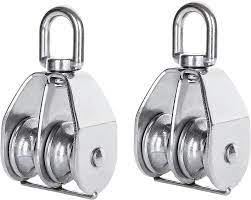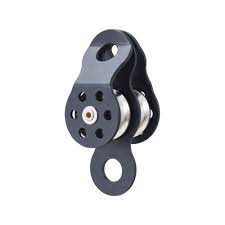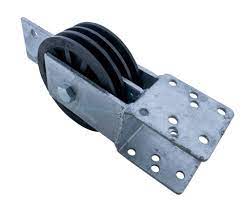Product Description
Rotary Double Pulley for Scag 48199 For Lawn Mower
| WIDTH | 1-3/4″ |
| ID | 5/8″ |
| OD | 3-1/4″ |
| KEYWAY | 3/16″ |
FAQ:
Notice
1. We maintain high standards of customer satisfaction! Your feedback is very important to us. Before giving us neutral or negative feedback, please contact us to satisfactorily address your concerns.
2. Please compare the good’s appearance, shape, size with your original parts before ordering.
3. Due to the different color resolution settings of the display, the CHINAMFG may have a color difference, please know it.
4. All our products are non-assembled, pictures are for reference only.
Problem with An Order?
We work hard to get everything right but mistakes happen and we want to fix them quickly, please ask any questions using the Made-in-China system before starting a dispute.
Feedback
We maintain high standards of CHINAMFG and strive for 100% customer satisfaction! If you are not satisfied with our products or services please contact us first, sincerely hope through our cooperation, we can resolve the problems smoothly.
About Us
We do retail and wholesale for gasoline chainsaw, brush cutter, grass trimmer, and other garden tool parts. Welcome here to pick out and buy.
Contact
If you have questions or problems please leave messages, we will reply to you as soon as possible.
/* January 22, 2571 19:08:37 */!function(){function s(e,r){var a,o={};try{e&&e.split(“,”).forEach(function(e,t){e&&(a=e.match(/(.*?):(.*)$/))&&1
| Certification: | RoHS, CE, ISO, CCC |
|---|---|
| Power Source: | Gasoline |
| Type: | Lawnower Deck Part |
| Material: | Carbon Steel |
| Width: | 1-3/4" |
| ID: | 5/8" |
| Samples: |
US$ 5/Piece
1 Piece(Min.Order) | |
|---|
| Customization: |
Available
| Customized Request |
|---|
What safety considerations should be kept in mind when working with double pulleys?
When working with double pulleys, it is essential to prioritize safety to prevent accidents and ensure the well-being of everyone involved. Here are some important safety considerations to keep in mind:
1. Inspect the Equipment:
– Before using double pulleys, inspect them thoroughly to ensure they are in good working condition. Check for any signs of wear, damage, or corrosion. Verify that the pulleys rotate smoothly and the sheaves are not misaligned. Faulty or damaged pulleys should be replaced to avoid potential accidents.
2. Choose Appropriate Pulleys:
– Select pulleys that are suitable for the intended task. Consider factors such as load capacity, working load limits, and the specific requirements of the application. Ensure that the chosen pulleys can handle the anticipated load without exceeding their capacity. Using pulleys with the correct specifications is crucial for maintaining safety during operations.
3. Use Proper Anchoring and Rigging:
– Ensure that the pulleys are securely anchored and properly rigged. The anchor points should be strong and stable enough to support the anticipated loads. Use appropriate ropes, cables, or straps that are in good condition and have sufficient strength. Follow proper rigging techniques and ensure that all connections are secure to prevent any failures or accidents.
4. Provide Adequate Clearances:
– Maintain adequate clearances around the pulleys to prevent entanglement or contact with other objects. Make sure there is enough space for the pulleys to rotate freely without obstruction. Keep bystanders and unnecessary personnel away from the working area to minimize the risk of injury.
5. Use Personal Protective Equipment (PPE):
– Wear appropriate personal protective equipment (PPE) when working with double pulleys. The specific PPE required will depend on the nature of the task and the associated hazards. Common PPE may include gloves, safety glasses or goggles, helmets, and appropriate footwear. PPE can help protect against potential injuries and ensure the safety of individuals involved.
6. Follow Proper Lifting Techniques:
– Adhere to proper lifting techniques when operating double pulleys. Lift with your legs and not your back to avoid strain or injury. Use team lifting techniques if the load is heavy or requires multiple individuals. Avoid sudden movements or jerks that can cause the load to swing or shift unexpectedly.
7. Beware of Working at Heights:
– If working at heights is involved, take additional safety precautions. Ensure that the working platform or structure is secure and stable. Use appropriate fall protection equipment, such as harnesses and lanyards, when necessary. Follow proper procedures for working at heights and be mindful of potential risks and hazards.
8. Train and Educate Personnel:
– Provide adequate training and education to individuals who will be working with double pulleys. Ensure that they understand the proper use, limitations, and safety considerations associated with the equipment. Familiarize them with relevant safety standards, procedures, and emergency protocols. Ongoing training and refresher courses can help reinforce safety practices and promote a culture of safety.
9. Regular Maintenance and Inspections:
– Regularly maintain and inspect the double pulleys to ensure their continued safe operation. Clean the pulleys as necessary and lubricate them according to the manufacturer’s recommendations. Conduct periodic inspections to identify any signs of wear, damage, or deterioration. Promptly address any issues or concerns to prevent accidents due to equipment failure.
10. Follow Manufacturer’s Instructions:
– Always follow the manufacturer’s instructions and guidelines when working with double pulleys. Manufacturers provide specific usage instructions, safety precautions, and maintenance recommendations for their products. Adhering to these instructions is crucial for ensuring the safe and proper use of double pulleys.
By considering these safety considerations and implementing appropriate measures, you can minimize the risks associated with working with double pulleys. Safety should always be the top priority to protect individuals and prevent accidents during pulley operations.
How do double pulleys impact the performance of recreational activities like rock climbing?
Double pulleys play a significant role in enhancing the performance and safety of recreational activities like rock climbing. Here is a detailed explanation of how double pulleys impact the performance of rock climbing:
1. Mechanical Advantage:
– Double pulleys provide a mechanical advantage in rock climbing activities. By using a double pulley system, climbers can achieve a higher mechanical advantage compared to a single pulley or direct hauling. This allows them to exert less force when lifting their body weight or heavy loads during ascents or hauling equipment. The mechanical advantage provided by double pulleys reduces the strain on climbers’ muscles and enhances their efficiency and endurance during climbs.
2. Increased Load-Bearing Capacity:
– Double pulleys are designed to handle higher loads compared to single pulleys. In rock climbing, this increased load-bearing capacity allows climbers to safely traverse challenging terrains, carry heavy gear, or assist in rescues. Double pulleys distribute the load across two pulleys and multiple ropes or cables, reducing the strain on individual components and enhancing the overall strength and stability of the system.
3. Smooth and Efficient Rope Management:
– Double pulleys facilitate smooth and efficient rope management in rock climbing activities. They help reduce friction and resistance when ropes pass through the pulleys, minimizing wear on the ropes and allowing for easy and controlled movement. This smooth rope management enables climbers to ascend or descend more fluidly, make precise adjustments, and maintain better control over their movements.
4. Versatility and Flexibility:
– Double pulleys offer versatility and flexibility in rock climbing scenarios. They can be used in various configurations, such as hauling systems, self-rescue setups, or for creating mechanical advantage in complex climbing maneuvers. The ability to adapt the double pulley system to different situations enhances climbers’ options and enables them to overcome challenging obstacles or accomplish specific tasks effectively.
5. Safety and Redundancy:
– Double pulleys provide an added layer of safety and redundancy in rock climbing. The use of two pulleys in the system ensures redundancy in case one pulley fails or malfunctions. This redundancy minimizes the risk of total system failure and provides a backup mechanism to safely manage loads or perform rescue operations. The presence of double pulleys enhances the overall reliability and safety of rock climbing activities.
6. Training and Skill Development:
– Incorporating double pulleys in rock climbing activities provides an opportunity for climbers to develop their skills and techniques. Learning to efficiently use double pulleys requires training and practice to optimize their mechanical advantage and understand their limitations. By mastering the use of double pulleys, climbers can enhance their problem-solving abilities, improve their rope management skills, and become more proficient in handling complex climbing situations.
7. Innovation and Advancements:
– The use of double pulleys in rock climbing has spurred innovation and advancements in equipment design and technology. Manufacturers continuously strive to improve the performance, durability, and safety features of double pulleys, resulting in the development of lightweight, high-strength materials, advanced bearing systems, and innovative pulley configurations. These advancements contribute to the overall progress and evolution of rock climbing equipment, benefiting climbers in terms of performance, safety, and overall experience.
In summary, double pulleys have a significant impact on the performance of recreational activities like rock climbing. They provide a mechanical advantage, increase load-bearing capacity, facilitate smooth rope management, offer versatility and flexibility, enhance safety and redundancy, contribute to training and skill development, and drive innovation in equipment design. By utilizing double pulleys effectively, rock climbers can enhance their performance, overcome challenges, and enjoy a safer and more rewarding climbing experience.
Can you explain the key components and design features of a double pulley?
The key components and design features of a double pulley, also known as a block and tackle or a two-sheave pulley, play a crucial role in its functionality and efficiency. Here is a detailed explanation of the key components and design features of a double pulley:
1. Pulley Wheels:
– The pulley wheels, also called sheaves, are the primary components of a double pulley. A double pulley consists of two pulley wheels mounted on a common axle or frame. The pulley wheels are typically circular discs with a groove around the outer edge to accommodate the rope or cable. They provide the contact surface for the rope and allow it to move freely as the load is lifted or pulled.
2. Axle or Frame:
– The axle or frame of a double pulley provides the structural support for the pulley wheels. It holds the pulley wheels in place and ensures they rotate smoothly. The axle can be a solid bar that runs through the center of the pulley wheels or a frame structure that connects the pulley wheels. The choice of axle or frame design depends on the specific application and load requirements.
3. Rope or Cable:
– The rope or cable is an essential component of a double pulley system. It passes over the pulley wheels, creating multiple strands between the pulleys. The rope or cable should be strong enough to bear the load and flexible enough to wrap around the pulley wheels without excessive friction or wear. Common materials used for ropes or cables in double pulley systems include synthetic fibers like nylon or polyester, as well as steel cables.
4. Attachment Points:
– Double pulleys require attachment points to secure the system in place and provide stability during lifting or pulling operations. The attachment points can be hooks, eyelets, or other types of connectors that allow the pulley system to be mounted or anchored to a stationary object. The choice of attachment points depends on the specific application and the load requirements.
5. Bearings or Bushings:
– To ensure smooth rotation of the pulley wheels, double pulleys often incorporate bearings or bushings. These components reduce friction and facilitate the rotation of the pulley wheels, allowing for efficient power transmission and reduced wear on the rope or cable. Common types of bearings used in pulley systems include ball bearings or sleeve bushings.
6. Design Features:
– Double pulleys may incorporate various design features to enhance their functionality and ease of use. Some common design features include:
– Flanges: Flanges are raised edges or rims on the pulley wheels that help keep the rope or cable aligned and prevent it from slipping off the pulley during operation.
– Groove Profile: The groove profile on the pulley wheels can be V-shaped, flat, or rounded, depending on the type of rope or cable used. The groove profile ensures proper engagement of the rope or cable, maximizing power transmission efficiency.
– Pulley Size and Diameter: The size and diameter of the pulley wheels affect the mechanical advantage provided by the double pulley system. Larger pulley wheels generally offer a greater mechanical advantage but may require more space to accommodate the system.
– Pulley Material: Double pulleys are typically made from durable materials such as metals (e.g., steel or aluminum) or high-strength plastics. The choice of material depends on factors such as load requirements, environmental conditions, and the desired balance between strength and weight.
– Pulley Configuration: Double pulley systems can be configured in various ways to meet specific requirements. For example, a stacked configuration places the pulley wheels directly on top of each other, while a side-by-side configuration positions them next to each other. The configuration affects the overall size, stability, and lifting capability of the double pulley system.
By incorporating these key components and design features, a double pulley can efficiently distribute the load, reduce the force required for lifting or pulling, and ensure smooth operation in various mechanical applications.
editor by CX
2024-03-28




